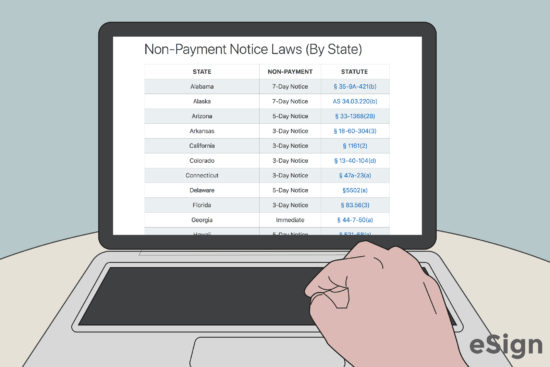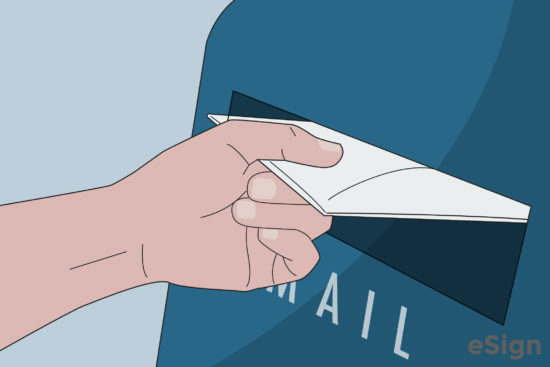Notices: By State
- Alabama
- Alaska
- Arizona
- Arkansas
- California
- Colorado
- Connecticut
- Delaware
- Florida
- Georgia
- Hawaii
- Idaho
- Illinois
- Indiana
- Iowa
- Kansas
- Kentucky
- Louisiana
- Maine
- Maryland
- Massachusetts
- Michigan
- Minnesota
- Mississippi
- Missouri
- Montana
- Nebraska
- Nevada
- New Hampshire
- New Jersey
- New Mexico
- New York
- North Carolina
- North Dakota
- Ohio
- Oklahoma
- Oregon
- Pennsylvania
- Rhode Island
- South Carolina
- South Dakota
- Tennessee
- Texas
- Utah
- Vermont
- Virginia
- Washington
- West Virginia
- Wisconsin
- Wyoming
Contents |
Sample
NOTICE TO PAY OR QUIT FOR NON-PAYMENT
Date: [MM/DD/YYYY]
To: [TENANT NAME(S)]
Address: [RENTAL ADDRESS]
You are notified that you owe rent in the amount of $[AMOUNT OWED]. This amount does not include any late fees that you may also owe. You may not be evicted for non-payment of late fees.
If you do not pay this rent by the date stated below, which must be at least [#] days after the date and time you receive this notice, your tenancy will be terminated, and you will be required to move.
Date and time by which rent must be paid:
Date: [MM/DD/YYYY]
Time: [HH:MM] (☐ AM | ☐ PM)
You do not have to move if you pay your rent in full before the date and time above.
If you do NOT pay your rent or move by the date and time above, a lawsuit may be filed to evict you.
Landlord / Agent Signature: ________________________
Printed Name: [LANDLORD NAME]
CERTIFICATE OF SERVICE
I certify that on [MM/DD/YYYY], I served this notice to [RECIPIENT NAME] by:
☐ – Delivering it personally to the person in possession of the Premises.
☐ – Delivering it to the Premises to a member of the Tenants’ family or household or an employee of suitable age and discretion with a request that it be delivered to the person in possession.
☐ – Certified first-class mail addressed to the person in possession.
Landlord / Agent Signature: ________________________
What is a Notice to Quit? (Non-Payment)
A notice to quit for non-payment is a letter delivered to tenants who have become delinquent (late) on rent. The form is one of the first steps a landlord will take in the eviction process. The letter provides the tenant with a deadline by which they must have all outstanding rent and applicable fees paid. Even if the tenant vacates the rental, they will most likely be required to pay all rent payments until the lease ends or the landlord finds a new tenant. A notice to quit should only be delivered by certified mail, which is a service provided by USPS that serves as legal proof the letter was signed by the tenant.
How to Give a Tenant a Notice to Quit
Oftentimes, the method by which a notice to quit is delivered to the tenant can make or break whether or not the judge sides with the landlord. Because if a tenant can prove the landlord didn’t take the proper steps in notifying them of the eviction, the case will most likely be thrown out.
To avoid this scenario, the landlord needs to ensure they have undeniable proof that one of the following actions occurred:
- The tenant received the notice personally, or
- A reasonable effort was made in providing notice to the tenant.
The following steps cover what is needed to properly issue a notice to quit to a tenant:
Step 1 – Look up State Laws
While most eviction lawsuits end in the landlord’s favor, the lawsuits that don’t are often due to errors in delivering the notice or not maintaining a proper paper trail during the eviction process. One of the most common defenses tenants use is that they didn’t know of the eviction or weren’t aware they did anything wrong.
Depending on the state in which eviction will take place, landlords may need to wait anywhere from one (1) to thirty (30) days, although the average time is seven (7) days. It’s always best to download the notice specific to your state to ensure the eviction process is carried out correctly.
Step 2 – Deliver the Notice
Once the correct notice type has been completed and printed out, it needs to be delivered to the tenant in a manner that complies with state law. Delivering the notice per state statutes is essential. The landlord must prove in court that the notice was sent to the tenant on a specific date and that a significant effort was made to guarantee the tenant received the letter.
Offered through the United States Postal Service (USPS), certified mail provides landlords with “electronic verification” that a delivery (or a delivery attempt) was made. Additionally, by purchasing Return Receipt Service, landlords will obtain an official receipt of the tenant’s signature, proving that the tenant obtained the notice. Proof of delivery includes the following information:
- The date the notice was delivered;
- The signature of the tenant; and
- The tenant’s address (which should be the same address the notice was delivered to).
Step 3 – Wait the Required Time
Known as the “cure period,” the landlord will need to wait the state-mandated length of time (which is mentioned on the notice) to give the tenant time to pay the rent in full. As long as the tenant is not a repeat offender (in which case the notice can be made “incurable”), the tenant can pay their rent within the aforementioned timeframe, and the landlord no longer has a legally valid reason for evicting the tenant.
Non-Payment Notice Laws: By State
| STATE | NON-PAYMENT | STATUTE |
| Alabama | 7-Day Notice | § 35-9A-421(b) |
| Alaska | 7-Day Notice | AS 34.03.220(b) |
| Arizona | 5-Day Notice | § 33-1368(2B) |
| Arkansas | 3-Day Notice | § 18-60-304(3) |
| California | 3-Day Notice | § 1161(2) |
| Colorado | 3-Day Notice | § 13-40-104(d) |
| Connecticut | 3-Day Notice | § 47a-23(a) |
| Delaware | 5-Day Notice | §5502(a) |
| Florida | 3-Day Notice | § 83.56(3) |
| Georgia | Immediate | § 44-7-50(a) |
| Hawaii | 5-Day Notice | § 521-68(a) |
| Idaho | 3-Day Notice | § 6-303(2) |
| Illinois | 5-Day Notice | § 9-209 |
| Indiana | 10-Day Notice | § 32-31-1.6 |
| Iowa | 3-Day Notice | § 562A.27(2) |
| Kansas | 10-Day Notice | § 58-2507 |
| Kentucky | County Based | County Based |
| Louisiana | 5-Day Notice | Art. 4701 |
| Maine | 7-Day Notice | § 6002 (1) |
| Maryland | Immediate | § 8-401 |
| Massachusetts | 14-Day Notice | Ch. 186 § 11 |
| Michigan | 7-Day Notice | § 554.134(2) |
| Minnesota | 14-Day Notice (periodic leases only) | § 504B.135(b) |
| Mississippi | 3-Day Notice | § 89-7-27 |
| Missouri | Immediate | § 535.060 |
| Montana | 3-Day Notice | § 70-24-422(2) |
| Nebraska | 7-Day Notice | § 76-1431(2) |
| Nevada | 7-Day Notice | NRS 40.2512(1) |
| New Hampshire | 7-Day Notice | § 540.3(I) |
| New Jersey | 30-Day Notice | § 2A:18-61.2 |
| New Mexico | 3-Day Notice | § 47-8-33(D) |
| New York | 14-Day Notice | § 711(2) |
| North Carolina | 10-Day Notice | § 42-3 |
| North Dakota | 3-Day Notice | § 47-32 |
| Ohio | 3-Day Notice | § 1923.02(5a) |
| Oklahoma | 5-Day Notice | § 131(B) |
| Oregon | 6-Day Notice | § 90.394(2)(b) |
| Pennsylvania | 10-Day Notice | 250.501(b) |
| Rhode Island | 5-Day Notice | § 34-18-35(a) |
| South Carolina | 5-Day Notice | § 27-40-710(B) |
| South Dakota | 3-Day Notice | § 21-16-1(4) |
| Tennessee | 14-Day Notice | § 66-7-109(a)(1)(A) |
| Texas | 3-Day Notice | § 24.005 |
| Utah | 3-Day Notice | § 78B-6-802 |
| Vermont | 14-Day Notice | § 4467(a) |
| Virginia | 5-Day Notice | § 55.1-1415 |
| Washington | 14-Day Notice | § 59.12.030(3) |
| West Virginia | Immediate | § 55-3A-1 |
| Wisconsin | 5-Day Notice | § 704.17(2)(a) |
| Wyoming | 3-Day Notice | § 1-21-1003 |




